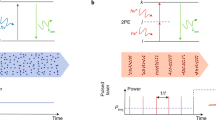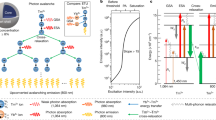Abstract
Multiphoton processes, predicted1 theoretically in 1931, were for a long time considered to be mainly of academic interest. This view changed when it was shown2,3 that a two-photon absorption process could, because of a quadratic dependence of excitation on intensity, produce a spatially confined excitation useful for three-dimensional data storage and imaging. Two-photon absorption has received considerable attention recently because of the development of highly efficient two-photon-sensitive materials, leading to numerous technological applications4,5,6,7,8,9,10,11,12,13,14,15,16,17,18,19,20,21,22,23,24,25,26,27,28. These successes have created interest in exploring applications based on three-photon excitations29. For a three-photon process, a longer excitation wavelength such as those common in optical communications can be used. Also, the cubic dependence of the three-photon process on the input light intensity provides a stronger spatial confinement, so that a higher contrast in imaging can be obtained. Here we report the observation of a highly directional and up-converted stimulated emission as an amplified spontaneous emission, produced in an organic chromophore solution by a strong simultaneous three-photon absorption at 1.3 µm. This achievement suggests opportunities for a three-photon process in frequency-upconversion lasing, short-pulse optical communications, and the emerging field of biophotonics.
This is a preview of subscription content, access via your institution
Access options
Subscribe to this journal
Receive 51 print issues and online access
$199.00 per year
only $3.90 per issue
Buy this article
- Purchase on Springer Link
- Instant access to full article PDF
Prices may be subject to local taxes which are calculated during checkout





Similar content being viewed by others
References
Göppert-Meyer, M. Elementartakte mit zwei Quantensprüngen. Ann. Phys. 9, 275–294 (1931).
Parthenopoulos, D. A. & Rentzepis, P. M. Three-dimensional optical storage memory. Science 245, 843–845 (1989).
Denk, W., Strickler, J. H. & Webb, W. W. Two-photon laser scanning fluorescence microscopy. Science 248, 73–76 (1990).
Zhao, C. F., He, G. S., Bhawalkar, J. D., Park, C. K. & Prasad, P. N. Newly synthesized dyes and their polymer/glass composites for one- and two-photon pumped solid-state cavity lasing. Chem. Mater. 7, 1979–1983 (1995).
Reinhardt, B. A. et al. Highly active two-photon dyes: design, synthesis, and characterization toward application. Chem. Mater. 10, 1863–1874 (1998).
Kim, O.-K. et al. New class of two-photon-absorbing chromophores based on dithienothiophene. Chem. Mater. 12, 284–286 (2000).
Andronov, A. et al. Novel two-photon absorbing dendritic structures. Chem. Mater. 12, 2838–2841 (2000).
Kannan, R. et al. Diphenylaminofluorene-based two-photon-absorbing chromophores with various π-electron acceptors. Chem. Mater. 13, 1896–1904 (2001).
Ehrlich, J. B. et al. Two-photon absorption and broadband optical limiting with bis-donor stilbene. Opt. Lett. 22, 1843–1845 (1997).
Albota, M. et al. Design of organic molecules with large two-photon absorption cross sections. Science 281, 1653–1656 (1998).
Belfield, K. D., Schafer, K. J., Mourad, W. & Reinhardt, B. A. Synthesis of new two-photon absorbing fluorene derivatives via Cu-mediated Ullmann condensations. J. Org. Chem. 65, 4475–4481 (2000).
He, G. S., Bhawalkar, J. D., Zhao, C. F., Park, C.-K. & Prasad, P. N. Two-photon-pumped cavity lasing in a dye-solution-filled hollow-fiber system. Opt. Lett. 20, 2393–2395 (1995).
He, G. S., Yuan, L., Cui, Y., Li, M. & Prasad, P. N. Studies of two-photon pumped frequency-upconverted lasing properties of a new dye material. J. Appl. Phys. 81, 2529–2537 (1997).
He, G. S., Signorini, R. & Prasad, P. N. Longitudinally two-photon pumped leaky waveguide dye film laser. IEEE J. Quantum Electron. 34, 7–13 (1998).
He, G. S. et al. Two-photon absorption and optical-limiting properties of novel organic compounds. Opt. Lett. 20, 435–437 (1995).
He, G. S. et al. Nonlinear optical properties of a new chromophore. J. Opt. Soc. Am. B 14, 1079–1087 (1997).
He, G. S., Weder, C., Smith, P. & Prasad, P. N. Optical power limiting and stabilization based on a novel polymer compound. IEEE J. Quantum Electron. 34, 2279–2285 (1998).
Dvormikov, A. S. & Rentzepis, P. M. Novel organic ROM materials for optical 3D memory devices. Opt. Commun. 136, 1–6 (1997).
Strickler, J. H. & Webb, W. W. Three-dimensional optical data storage in refractive media by two-photon point excitation. Opt. Lett. 16, 1780–1782 (1991).
Pudavar, H. E., Joshi, M. P., Prasad, P. N. & Reinhardt, B. A. High-density three-dimensional optical data storage in a stacked compact disk format with two-photon writing and single photon readout. Appl. Phys. Lett. 74, 1338–1340 (1999).
Parthenopoulos, D. A. & Rentzepis, P. M. Two-photon volume information storage in doped polymer systems. J. Appl. Phys. 68, 5814–5818 (1990).
Gura, T. Biologists get up close and personal with live cells. Science 276, 1988–1990 (1997).
Bhawalkar, J. D. et al. Nondestructive evaluation of polymeric paints and coatings using two-photon laser scanning confocal microscopy. Polymer 38, 4551–4555 (1997).
Wang, X. et al. A chemically labeled cytotoxic agent: Two-photon fluorophore for optical tracking of cellular pathway in chemotherapy. Proc. Natl Acad. Sci. USA 96, 11081–11084 (1999).
Bhawalkar, J. D., Kumar, N. D., Zhao, C. F. & Prasad, P. N. Two-photon photodynamic therapy. J. Clin. Laser Med. Surg. 15, 201–204 (1997).
Joshi, M. P., Pudavar, H. E., Swiatkiewicz, J., Prasad, P. N. & Reinhardt, B. A. Three-dimensional optical circuitry using two-photon-assisted polymerization. Appl. Phys. Lett. 74, 170–172 (1999).
Cumpston, B. H. et al. Two-photon polymerization initiators for three-dimensional optical data storage and microfabrication. Nature 398, 51–54 (1999).
Kawata, S., Sun, H.-B., Tanaka, T. & Takada, K. Finer features for functional microdevices. Nature 412, 697–698 (2001).
He, G. S., Bhawalkar, J. D. & Prasad, P. N. Three-photon-absorption-induced fluorescence and optical limiting effects in an organic compound. Opt. Lett. 20, 1524–1526 (1995).
Acknowledgements
This work was supported by the US Air Force Office of Scientific Research, Washington DC, and the Polymer Branch of the US Air Force Research Laboratory at Dayton.
Author information
Authors and Affiliations
Corresponding author
Ethics declarations
Competing interests
The authors declare no competing financial interests.
Rights and permissions
About this article
Cite this article
He, G., Markowicz, P., Lin, TC. et al. Observation of stimulated emission by direct three-photon excitation. Nature 415, 767–770 (2002). https://doi.org/10.1038/415767a
Received:
Accepted:
Issue Date:
DOI: https://doi.org/10.1038/415767a
This article is cited by
-
Biaxial strain tuned upconversion photoluminescence of monolayer WS2
Scientific Reports (2024)
-
Light activated drug deliveryplatform for dental applications- current technologies and future perspectives
Lasers in Dental Science (2024)
-
Multiphoton excited singlet/triplet mixed self-trapped exciton emission
Nature Communications (2023)
-
Giant five-photon absorption from multidimensional core-shell halide perovskite colloidal nanocrystals
Nature Communications (2017)
-
Cesium lead halide perovskite triangular nanorods as high-gain medium and effective cavities for multiphoton-pumped lasing
Nano Research (2017)
Comments
By submitting a comment you agree to abide by our Terms and Community Guidelines. If you find something abusive or that does not comply with our terms or guidelines please flag it as inappropriate.



